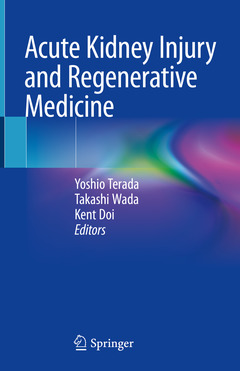Description
Acute Kidney Injury and Regenerative Medicine , 1st ed. 2020
Coordinators: Terada Yoshio, Wada Takashi, Doi Kent
Language: English
Subjects for Acute Kidney Injury and Regenerative Medicine :
Acute Kidney Injury and Regenerative Medicine
Publication date: 05-2020
Support: Print on demand
Publication date: 05-2020
Support: Print on demand
Acute Kidney Injury and Regenerative Medicine
Publication date: 05-2021
396 p. · 15.5x23.5 cm · Paperback
Publication date: 05-2021
396 p. · 15.5x23.5 cm · Paperback
Description
/li>Contents
/li>Biography
/li>Comment
/li>
This book presents up-to-date information on the clinical-pathophysiological features of acute renal injury and discusses the KDIGO diagnostic criteria, as well as novel experimental findings, including in the area of regenerative medicine. It also highlights the clinical-pathophysiological importance of AKI in clinical settings, including differential diagnoses and management of AKI.
In the past, the pathology associated with sudden renal impairment was characterized as acute renal failure (ARF). However, in the 2000s, the joint efforts of specialists in fields including nephrology, intensive care medicine, and cardiovascular medicine led to the introduction of a novel concept known as acute kidney injury (AKI). As medical care progressed, patients such as high-risk elderly subjects who were not deemed to be candidates for invasive therapy came to be treated in intensive care units (ICUs). As a result, kidney injury as a subset of multiple organ failure was re-considered as AKI, especially in intensive care medicine. AKI was then proposed as a novel disease concept to emphasize the importance of early diagnosis and early intervention to improve prognosis.
Presenting novel features, such as the definition of AKI, risk factors and management; biomarkers, such as neutrophil gelatinase-associated lipocalin (NGAL) and L-type fatty acid-binding protein (L-FABP); long-term outcomes of AKI; as well as renal regeneration using iPS cell, manipulation of embryonic genes, and Xenotransplanted embryonic kidney, this book is of interest to all physicians and researchers in this field around the globe.
Part 1 Diagnosis and risk factors of AKI.- Definition and epidemiology of AKI.- Cause of AKI (prerenal, renal, postrenal).- Pathophysiology of AKI.- Diagnosis of AKI (clinical assessment, novel biomarkers).- Risk factors for AKI development in surgery.- Risk factors for AKI development in heart failure.- 7. Contrast-induced AKI.- 8. Antibiotics- and immunosuppression-related AKI.- 9. AKI in setting of cancer.- Community-acquired AKI and hospital-acquired AKI.- Part 2 Complication of AKI.- 11. Complication of homeostasis (mineral and acid-base).- 12. Volume overload and cardiac and pulmonary complication.- Part 3 Prevention and management of AKI.- Prerenal and renal AKI.- Postrenal AKI.- AKI in intensive care medicine.- Nondialytic supportive management of AKI.- Renal replacement therapy in AKI.- Outcomes and long-term follow-up of AKI patients.- Prevention and management of pediatric AKI.- Part 4 Experimental novel findings.- AKI-to-CKD transition.- AKI and nerve system.- AKI and immune system.- AKI and cytokines.- Part 5 AKI and regenerative medicine.- iPS cell and renal regenerative medicine.- Embryonic genes and renal regenerative medicine.- Xenotransplanted embryonic kidney.
Prof. Yoshio Terada
Department of Endocrinology, Metabolism and Nephrology, Kochi Medical School, Kochi University, Japan
Department of Acute Medicine, The University of Tokyo, Japan
Department of Endocrinology, Metabolism and Nephrology, Kochi Medical School, Kochi University, Japan
Prof. Takashi Wada
Vice President, Kanazawa University, Japan
Department of Nephrology and Laboratory Medicine, Kanazawa University, Japan
Department of Acute Medicine, The University of Tokyo, Japan
Offers up-to-date information on the clinical-pathophysiological features of acute renal injury (AKI)
Presents new findings in AKI with plenty of experimental data
Covers regenerative medicine in the context of AKI and renal diseases
© 2024 LAVOISIER S.A.S.




